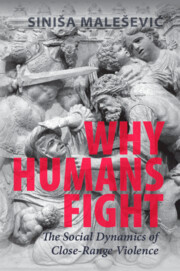Book contents
- Why Humans Fight
- Why Humans Fight
- Copyright page
- Dedication
- Contents
- Acknowledgements
- Introduction
- 1 The Body and the Mind
- 2 Profiting from Fighting
- 3 Clashing Beliefs
- 4 Enforced Fighting
- 5 Fighting for Others
- 6 Avoiding Violence
- 7 Social Pugnacity in the Combat Zone
- 8 Organisational Power and Social Cohesion on the Battlefield
- 9 Emotions and Close-Range Fighting
- 10 Killing in War
- 11 The Future of Close-Range Violence
- Conclusion
- Appendix Methodology and Data Collection
- References
- Index
9 - Emotions and Close-Range Fighting
Published online by Cambridge University Press: 29 September 2022
- Why Humans Fight
- Why Humans Fight
- Copyright page
- Dedication
- Contents
- Acknowledgements
- Introduction
- 1 The Body and the Mind
- 2 Profiting from Fighting
- 3 Clashing Beliefs
- 4 Enforced Fighting
- 5 Fighting for Others
- 6 Avoiding Violence
- 7 Social Pugnacity in the Combat Zone
- 8 Organisational Power and Social Cohesion on the Battlefield
- 9 Emotions and Close-Range Fighting
- 10 Killing in War
- 11 The Future of Close-Range Violence
- Conclusion
- Appendix Methodology and Data Collection
- References
- Index
Summary
There is no doubt that close-range fighting entails distinct emotional dynamics. People who take part in violent encounters experience intense emotional responses ranging from fear, angst, anxiety, panic, and horror to anger, rage, boredom, and even elation. The acts of fighting are often preceded and followed by physiological changes such as increased heart rate, heavy breathing, dilation of the pupils, hormonal increases, and in some case the loss of urinary or bowel control. Since emotions have dominated battlefields for centuries there is a well-entrenched view that warfare generates very similar emotional reactions among soldiers. The conventional interpretations overemphasise a uniform response by humans who find themselves in similar extraordinary situations (Grossman 2004; Holmes 1985; Keegan 1994). This chapter challenges such established views and argues that the emotional dynamics of close-range fighting is historically variable and culturally flexible. The historical and sociological analysis of battlefield experiences indicates that there are substantial cultural and historical differences in the emotional reactions of individuals and groups who experience similar fighting situations.
Keywords
- Type
- Chapter
- Information
- Why Humans FightThe Social Dynamics of Close-Range Violence, pp. 251 - 273Publisher: Cambridge University PressPrint publication year: 2022

